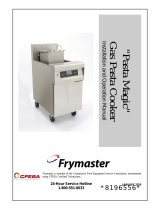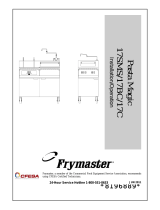
1-3
delivers 80,000 BTUs (23.4 kW – 84.4, megajoules) to cook 10 pounds (4.5kg) of dry pasta per bulk
basket. The cooker can also be used to reheat up to 12 10-ounce (0.28kg) packages of pre-cooked
food at a time. The cookpot measures 18 x 24 x 8 inches (457 x 610 x 203 mm) and holds 2.7
gallons (48-liters) of water.
Model Comparison:
GSMS: The “Gas Spaghetti Magic System” consists of a gas cooker and rinse tank
combination. The unit is equipped with a programmable controller that controls water
temperature, water level, and cooking times. A swing-away water faucet is standard. An
automatic basket lift system lowers and raises either bulk or individualized portions of pasta or
other food products according to times programmed by the operator. Options include
automatic water filling (Autofill) and starch skimming (Autoskim). The Autofill feature
maintains the cookpot water level approximately 11/4-inch (32mm) below the overflow drain.
The Autoskim feature sprays water on the surface of the water, forcing starch to the overflow
drain. This eliminates loss of cooking time associated with removing excess starch buildup. It
also keeps the water in the cookpot at the optimum level by replacing water evaporated
during the cooking process. The Autoskim feature also saves energy since there is no need to
refill and reheat the cookpot periodically. The cookpot is safeguarded against over filling and
boilover by a large overflow drain. “SD” following the model designation indicates a stainless
steel cookpot and door, and enameled cabinet. “SC” following the model designation
indicates all stainless steel components.
GBC/GC: These standalone cookers are essentially the same as the GSMS, but without the
built-in rinse tank. GBC models have an automatic basket lift and optional automatic water
filling and starch skimming. GC models have no basket lifts and no automatic water filling
and starch skimming options. The cookpot in both is safeguarded against over filling and
boilover by a large overflow drain. “SD” following the model designation indicates a stainless
steel cookpot and door, and an enameled cabinet. “SC” following the model designation
indicates all stainless steel components.
1.6 Installation, Operating, and Service Personnel
All installation and service on Frymaster equipment must be performed by qualified, certified,
licensed, and/or authorized installation or service personnel, as defined in Section 1.7.
1.7 Definitions
QUALIFIED INSTALLATION PERSONNEL
Qualified installation personnel are individuals, firms, corporations, and/or companies which, either in
person or through a representative, are engaged in and are responsible for the installation of gas-fired
appliances. Qualified personnel must be experienced in such work, be familiar with all gas
precautions involved, and have complied with all requirements of applicable national and local codes.
QUALIFIED OPERATING PERSONNEL
Qualified operating personnel are those who have carefully read the information in this manual and
have familiarized themselves with the equipment functions, or who have had previous experience with
the operation of the equipment covered in this manual.


























